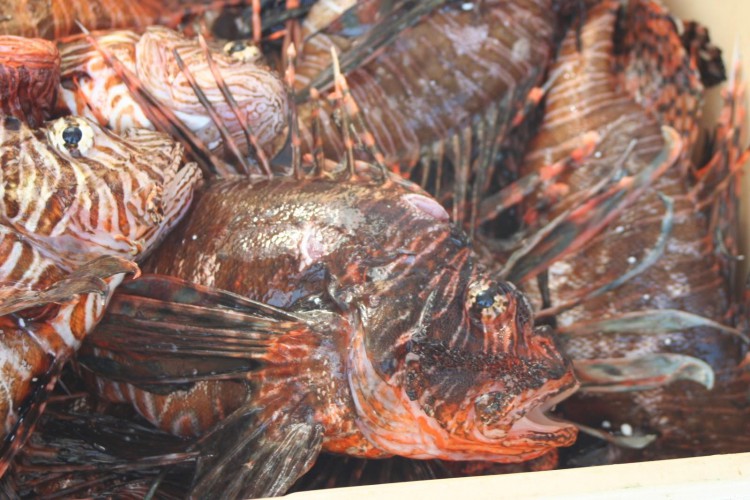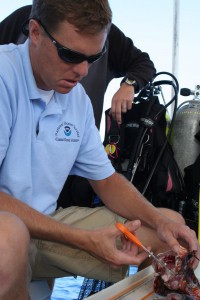First reported in the 1980s, the venomous Indo-Pacific lionfish (Pterois miles and P. volitans) is widely established along the Southeast U.S. and Caribbean. Now invading the Gulf of Mexico and South America, estimates of lionfish densities indicate lionfish even surpassed some native species. Lionfish could permanently impact native reef fish communities, as they occupy the same trophic position as economically important species (e.g., snapper and grouper) and this competition may hamper stock rebuilding efforts and coral reef conservation measures. Control and management of the lionfish invasion is needed to understand and mitigate the impacts of this unprecedented marine invasion. Efforts to control lionfish throughout the temperate and tropical Atlantic are utilizing various resources including harvesting as a foodfish, making it the first invasive marine fish promoted for consumption in the region.

On November 4th 2013, 44 representatives from governmentagencies, research institutions, non-government organizations, restaurants, seafood distributors, and fishers participated in a workshop held during the 66th annual meeting of the Gulf and Caribbean Fisheries Institute (GCFI) in Corpus Christi, Texas to identify the challenges of harvesting and distributing invasive lionfish as a means of control. Harvesting invasive lionfish for control presents several challenges including difficulty of capture, threat of envenomation, and potential liability associated with ciguatera fish poisoning (CFP) during invasive lionfish consumption.
Past research demonstrates that invasive lionfish are not only edible, buthave higher levels of healthy omega-3 fatty acids than other commonnative marine fish species.Furthermore, invasive lionfish have aflaky white meat similarto grouper. While the neurotoxic venom of the lionfish injected through its spines is primarily a threat to fishermen and those preparing the fish for consumption,ciguatoxin originates from the algaeGambierdiscus toxicusand accumulates in tropical fish that come in contact with it, posing a potential threat to the consumers. As CFP is not unique to lionfish, and is attributed to many subtropical and tropical fish species, CFP is a potential risk in some locations. Local managers and consumers are encouraged to assess local risk.
The workshop was partitioned into five objective-focused sessions including invasive lionfish and ciguatera, legal aspects of ciguatera, harvesting invasive lionfish, case studies of invasive lionfish in the marketplace, and invasive lionfish supply and distribution.

During the workshop, a final consensus of the GCFI Lionfish Workgroup lead to the agreement on the following outcomes:
- An invasive lionfish food fish market is practical, feasible, and should be promoted.
- Alternative invasive lionfish end-uses, such as the curio and aquarium trade, are also viable markets.
- Regarding consumption and the risk for CFP, invasive lionfish should not be treated differently than other fish species and a general caution statement (referring to all fish species collectively) should be displayed within all establishments that serve fish and on all fish products.
- Local control is effective at minimizing invasive lionfish impacts at local scales and should be encouraged where possible.
- Managers are encouraged to consider regulatory amendments in MPAs and other no-take areas to allow the removal of invasive lionfish.
The group also confirmed that further and continued research is necessary to identify best methods of invasive lionfish harvesting, priority harvesting areas, and conduct ciguatera toxin risk assessments.
The complete outcomes from the workshop are published in the Proceedings of the Gulf and Caribbean Fisheries Institute.
For more information, please contact James.Morris@noaa.gov
